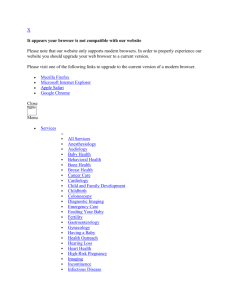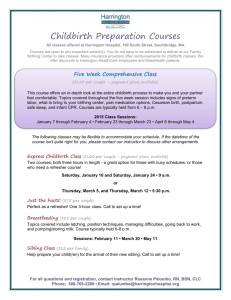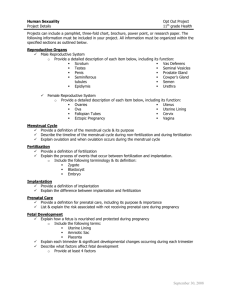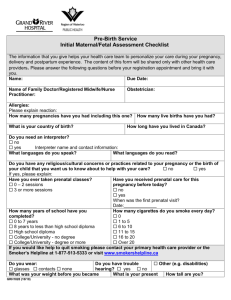Curriculum Development and Content for the Childbirth Educator
advertisement
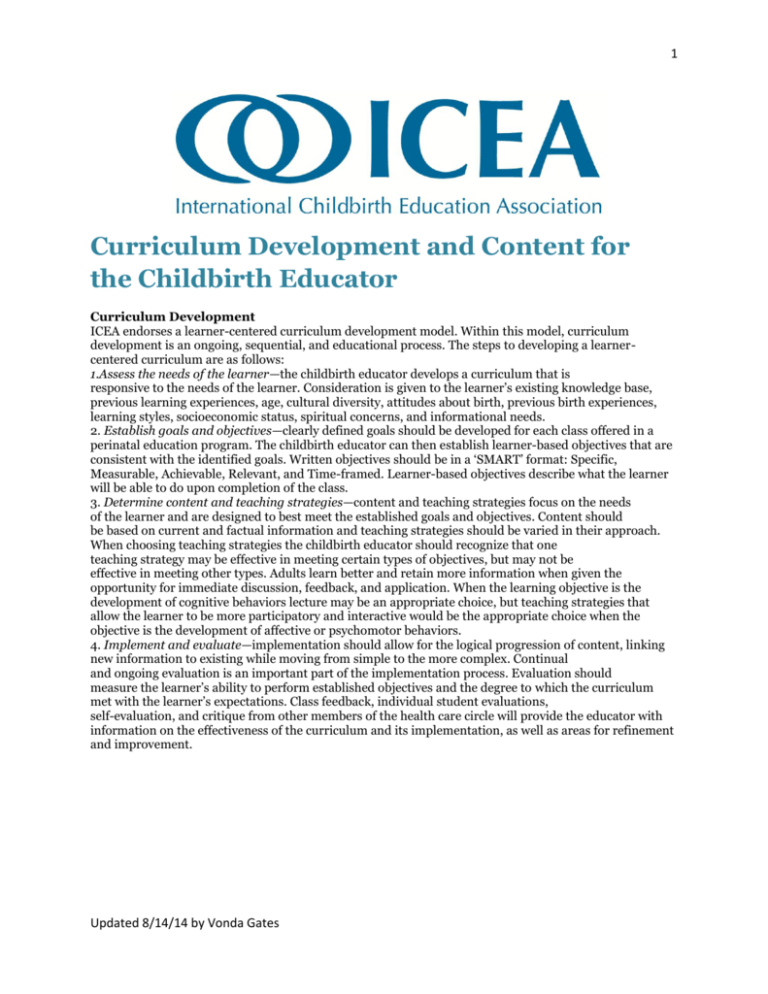
1 Curriculum Development and Content for the Childbirth Educator Curriculum Development ICEA endorses a learner-centered curriculum development model. Within this model, curriculum development is an ongoing, sequential, and educational process. The steps to developing a learnercentered curriculum are as follows: 1.Assess the needs of the learner—the childbirth educator develops a curriculum that is responsive to the needs of the learner. Consideration is given to the learner’s existing knowledge base, previous learning experiences, age, cultural diversity, attitudes about birth, previous birth experiences, learning styles, socioeconomic status, spiritual concerns, and informational needs. 2. Establish goals and objectives—clearly defined goals should be developed for each class offered in a perinatal education program. The childbirth educator can then establish learner-based objectives that are consistent with the identified goals. Written objectives should be in a ‘SMART’ format: Specific, Measurable, Achievable, Relevant, and Time-framed. Learner-based objectives describe what the learner will be able to do upon completion of the class. 3. Determine content and teaching strategies—content and teaching strategies focus on the needs of the learner and are designed to best meet the established goals and objectives. Content should be based on current and factual information and teaching strategies should be varied in their approach. When choosing teaching strategies the childbirth educator should recognize that one teaching strategy may be effective in meeting certain types of objectives, but may not be effective in meeting other types. Adults learn better and retain more information when given the opportunity for immediate discussion, feedback, and application. When the learning objective is the development of cognitive behaviors lecture may be an appropriate choice, but teaching strategies that allow the learner to be more participatory and interactive would be the appropriate choice when the objective is the development of affective or psychomotor behaviors. 4. Implement and evaluate—implementation should allow for the logical progression of content, linking new information to existing while moving from simple to the more complex. Continual and ongoing evaluation is an important part of the implementation process. Evaluation should measure the learner’s ability to perform established objectives and the degree to which the curriculum met with the learner’s expectations. Class feedback, individual student evaluations, self-evaluation, and critique from other members of the health care circle will provide the educator with information on the effectiveness of the curriculum and its implementation, as well as areas for refinement and improvement. Updated 8/14/14 by Vonda Gates 2 Content of Childbirth Classes Childbirth education encompasses the entire childbearing year and in its broadest definition includes preparation for pregnancy, labor, birth, postpartum, and early parenting, including breastfeeding, sexuality, changing relationships, and family planning. Classes should recognize that interests and information needs change as pregnancy progresses. Consequently educational offerings should include pre-conception, early pregnancy, mid-pregnancy, late pregnancy, and parenting classes that meet the needs of each community. ICEA’s position is that class schedules and content are best determined by the childbirth educator knowledgeable of community needs and practices. For the first time expectant parent a class series over several meetings is best however today’s busy client may be more comfortable in a one-time six hour class, divided into several sessions for those expectant parents who have never before attended a prepared childbirth class. For refresher and other specialized programs, such as condensed (weekend) classes, alternative planning is necessary so that an optimal learning experience is still provided. Class content may include: 1. The natural physiological and psychological patterns of pregnancy, labor, birth, and postpartum; 2. Common abnormal or unexpected variations on the usual patterns of the childbearing year; 3. Maternal and infant nutrition, including breastfeeding; 4. Common medical interventions and procedures during the labor and birth process as well as: Updated 8/14/14 by Vonda Gates 3 • obstetrical procedures and technologies, • vaginal, cesarean, and vaginal birth after a cesarean, • analgesia and anesthesia, • indications, contraindications, and benefits and risks for the above, and • alternatives to the above, whether or not available in the community. ICEA also recommends education in the following possible subject areas as appropriate: 1. Anatomy (male and female) and physiology of reproduction and sexuality during the childbearing year; 2. Fetal development and newborn characteristics; 3. Emotional changes of the father at each phase of pregnancy, birth, and postpartum; 4. Benefits of labor support; 5. The impact of pregnancy and parenthood on the couple relationship; 6. Family development; 7. Resources for dealing with unexpected outcome; 8. Perinatal screening and diagnostic procedures; 9. Teratogenic and iatrogenic influences in pregnancy; 10. The history and philosophy of childbirth education; and 11. The philosophy and practice of family-centered maternity care. ICEA does not promote one specific method of childbirth preparation. ICEA believes that there are many approaches that can help a woman cope with labor. Effectiveness in childbirth preparation is based on: 1. An appropriate match between the participant’s personal beliefs/philosophy and the approach taken by the educator; 2. A competent and supportive childbirth educator; 3. Adequate learning time that includes practice, discussion, and feedback; 4. Caring and knowledgeable birth attendants and support person(s); and 5. A supportive and nurturing birth environment. The class structure must provide time for class participants to discuss factual information as well as personal needs and goals. In addition, the childbirth educator should create an atmosphere that is conducive to values-clarification, problem solving, and informed decision-making. The educator recognizes that class size and environment have an important impact on these discussions. (See Practice Settings.) In addition, class format must provide adequate time for demonstration, return demonstration, and practice and review of: 1. Coping methods for labor, including: • relaxation skills, • breathing, either in a pattern or as a natural response to the forces of labor, and • comfort measures. 2. Body awareness and conditioning exercises for pregnancy, birth, and postpartum. Throughout the class series, advocacy of the following concepts should be evident: Updated 8/14/14 by Vonda Gates 4 1. The pregnant patients’ rights and responsibilities for making informed choices based on knowledge of alternatives; 2. Legal rights and informed consent; 3. Effective communication and negotiation with other members of the circle of care; 4. Breastfeeding as the preferred means of promoting infant nutrition and providing Immunological protection; 5. Promotion of pregnancy and birth as a significant and life changing event; 6. Parent-infant bonding; 7. Avoidance of routine medical intervention during pregnancy, birth, and postpartum, with the use of evidence-based medical treatment should complications arise; 8. Women-centered, baby-centered, and family-centered maternity care; 9. Parental participation, sharing, and individual satisfaction in vaginal and cesarean births; and 10. Consumer participation and advocacy in planning maternal and newborn services at all levels of the health care system. Updated 8/14/14 by Vonda Gates
